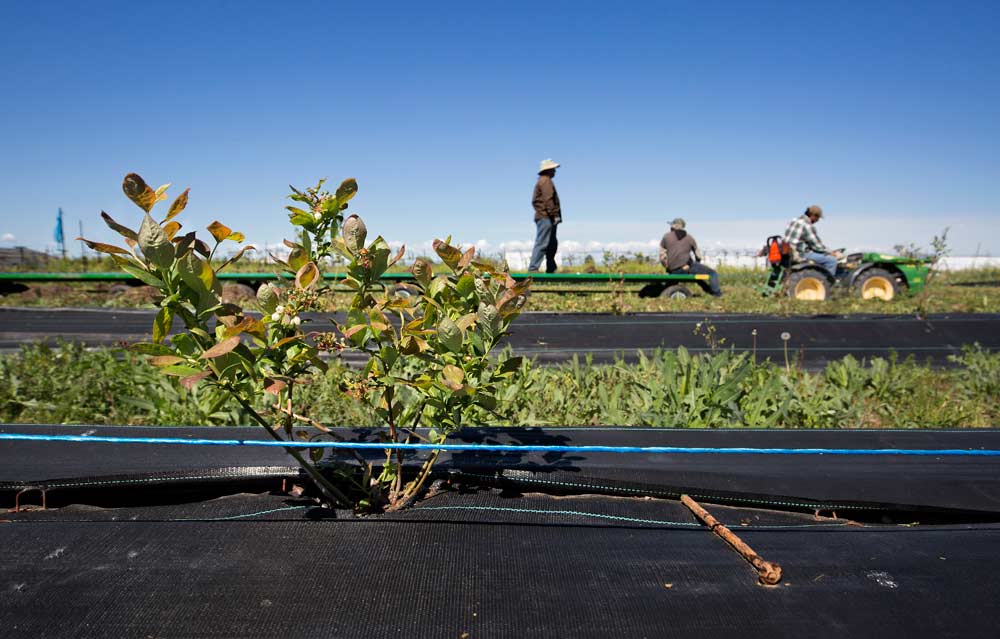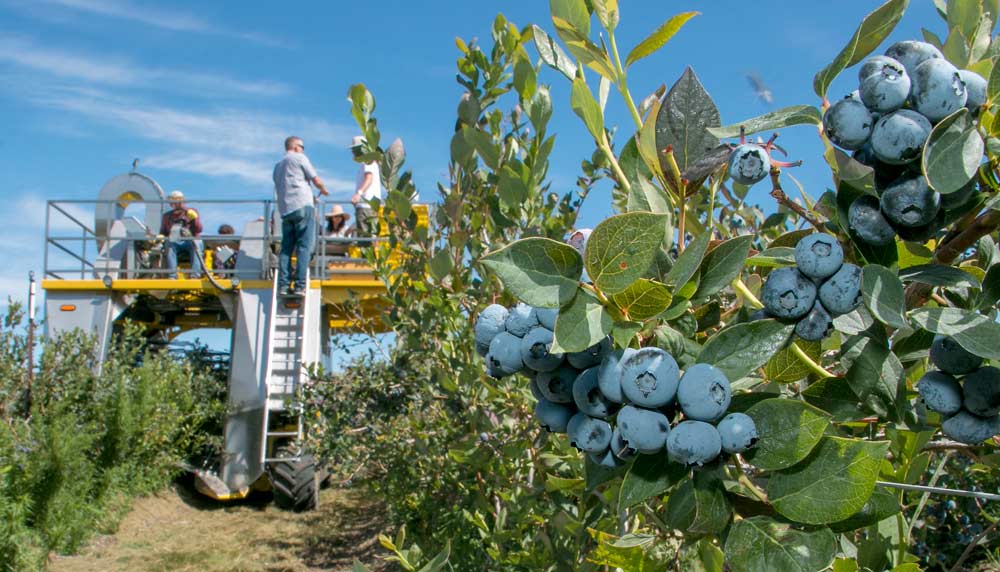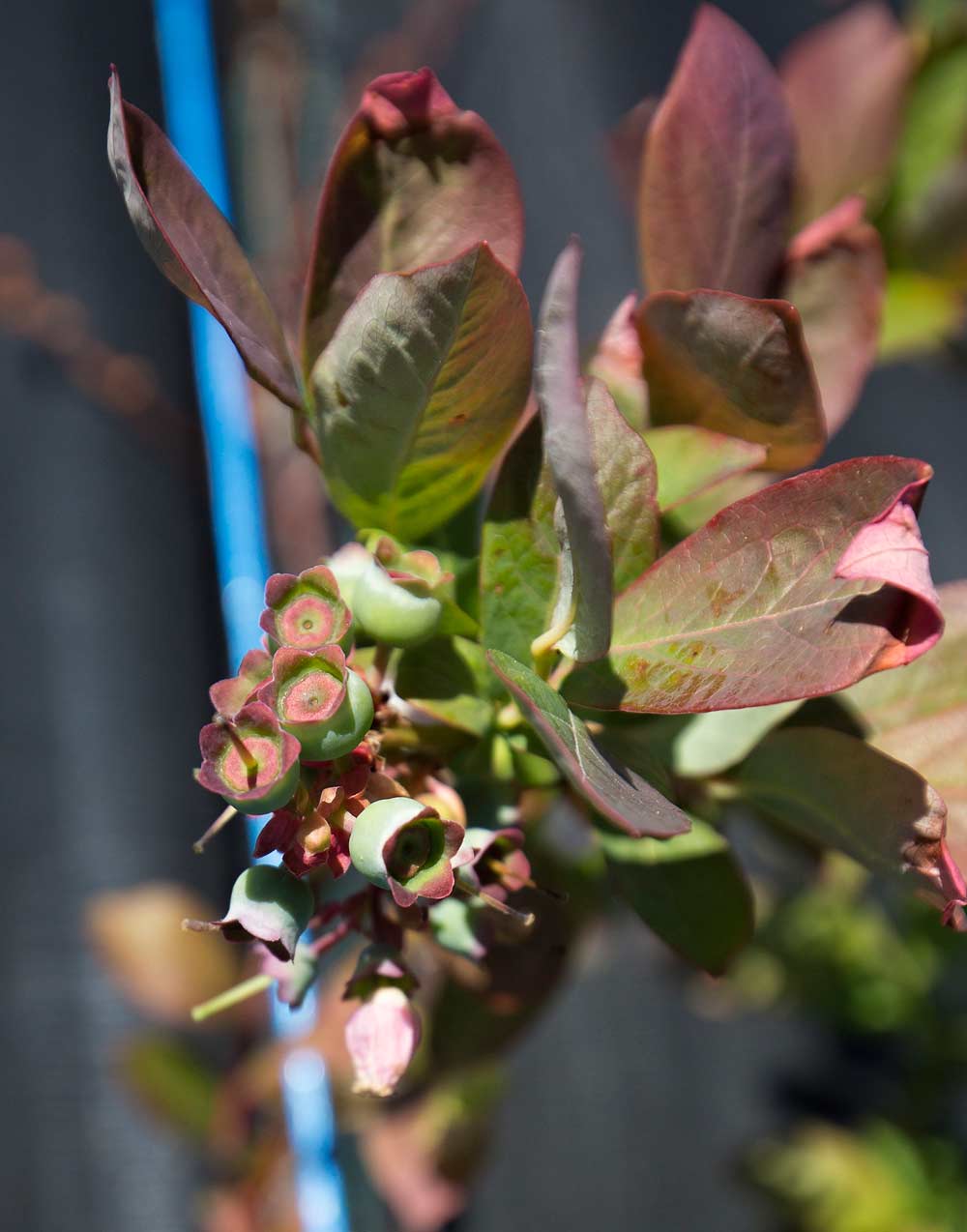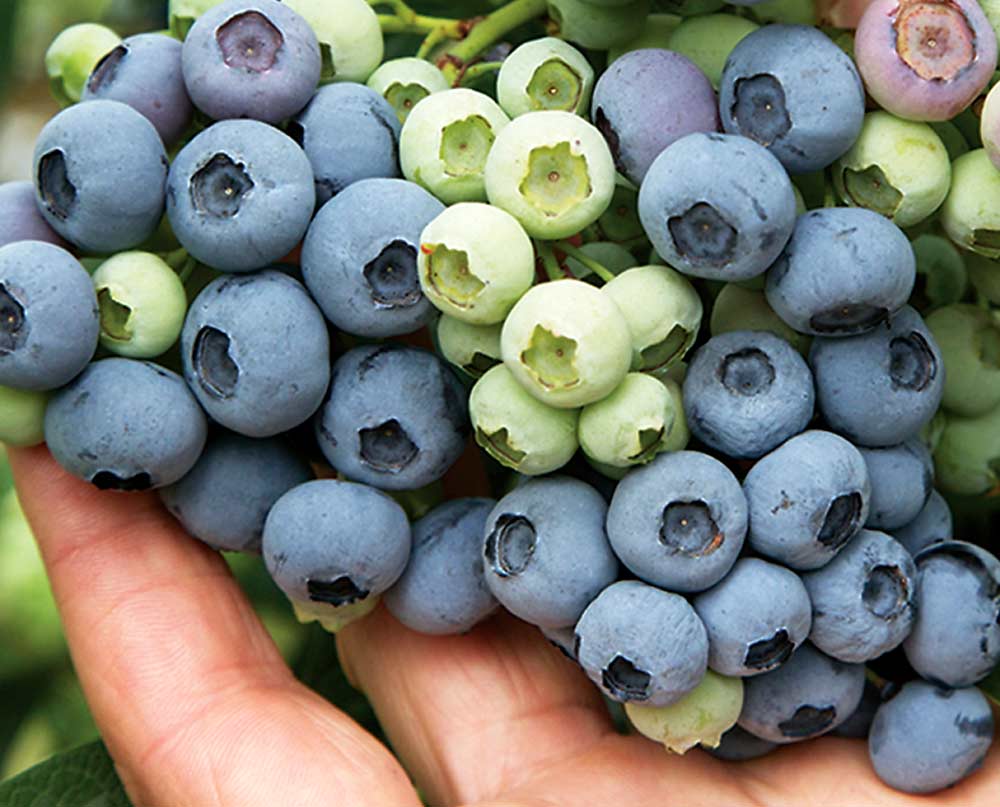
Crews at Blueberry Hill Berries in Wapato, Washington, are planting newer varieties like this particular one, Last Call, to spread out the farm’s growing season. (TJ Mullinax/Good Fruit Grower)
Like most blueberry growers, Jeff and Terri Weijohn of Blueberry Hill Berries have the bulk of their acreage in the Duke variety, the quiet workhorse of an industry that has seen unprecedented growth over the past 25 years.
But also like most blueberry growers, they are trying new varieties, looking for something that might ripen later and appeal to wholesale customers as fruit begins to fetch plateauing prices.
The Weijohns have several test rows of newcomers such as Last Call, Calypso and Clockwork at their Wapato, Washington, farm.
“We want to be dependable and provide berries for them throughout the season,” said Terri Weijohn.
Diversifying varieties and periodic price softening are common growing pains of any maturing industry, even so-called “super foods” like blueberries. Everyone knows apples went through the same problems 30 years ago.
But blueberries don’t follow all the same rules.
For one, most blueberry shoppers don’t care about variety. Other than a few direct-market exceptions such as U-pick or urban farm markets, consumers just want typical berries.
Retailers usually know the difference but label scant few varieties in the stores. Because of that, growers choose varieties to either offer a better product to their buyers — wholesale firms, packing sheds or retail stores — or extend their season.
Dukes typically ripen in June and July, considered the early season, while some of the newer varieties may extend harvest through August or longer.
Secondly, though blueberries were first cultivated in New Jersey in 1916, they grow anywhere and everywhere now, from northern, cold climates to the tropics.
Washington is the nation’s leading producer, but Georgia and Florida routinely make the Top 10 list. An ever-diversifying palette of varieties serves those different areas. Some, like cherries, require winter chill, while others don’t.
And they’re rapidly spreading overseas. The United States produces 55 percent of the world’s blueberries, but market share is gradually evening out with growth in Europe, South America and Asia, said David Brazelton, president of Fall Creek Nursery, a Lowell, Oregon, global plant supplier for the berry industry.
“Blueberries have become a global crop,” Brazelton said.
Brand trumps varieties

An over-the-row harvester picks Duke blueberries in July 2016 at Dorsing Farms in Royal City, Washington. Duke is a veteran variety that growers like for how well it tolerates mechanical harvesting for the frozen market, but the hunt is on for new varieties that might fill a niche for the mechanically harvested fresh market. (Ross Courtney/Good Fruit Grower)
In the U.S. fresh market, five or six major marketing companies control the bulk of fresh blueberry sales, and usually the genetics and production chain to ensure their supply, said Rod Cook, an Olympia, Washington, agricultural consultant.
Those companies — he declined to name them — offer plenty of different varieties, but keep the box labels generic, and have used their consolidation and market control to make fresh blueberries available on store shelves year-round.
That’s helped the blueberry industry overall, even if some small growers don’t like the resulting emphasis on brand over variety.
“There’s always winners and losers, but as an industry … this has been a positive thing,” Cook said.
The processed blueberry market, meanwhile, stands more independently than the processed apple industry.
Growers often choose varieties that lend themselves to mechanical harvest, using over-the-row machines with tines about the rigidity of a tent pole to comb the bushes and strip the fruit. Those are usually cleaned and frozen whole and packed in bags for shoppers to buy for smoothies or toppings for ice cream and yogurt.
Blueberries are easy to freeze and have become a popular item, typically in frozen bags at Costco and Walmart, stores that expect and demand a hefty, reliable volume.
Frozen f.o.b. prices have softened in the past few years to the tune of about 25 percent since November 2014, Cook said.
In addition, carryover inventory has steadily risen 2 to 3 percent in recent years as a natural attempt to supply an expanding market, surging dramatically by about 10 percent between the 2015 and 2016 crops due to a compressed 2015 harvest and increasing global competition for the Asian market.
The Pacific Northwest is the largest blueberry processing region in the nation and the most reliant on exports to Asia.
Staying ahead

Top Shelf blueberry variety at Blueberry Hill Berries on May 19, 2017, in Wapato, Washington. (TJ Mullinax/Good Fruit Grower)
All these dynamic industry changes have growers looking for new niches and varieties.
In Michigan, where stalwarts such as Jersey, Blue Crop and Elliott have paid the bills since the mid-20th century, growers are pulling them out in favor of Michigan State University varieties such as Liberty and Aurora, said Mark Longstroth of MSU Extension.
They are driven not only by the market, but by pests like spotted wing drosophila and blueberry stem gall wasp that prefer Jersey blooms.
“It’s become a big problem in the northern growing area,” Longstroth said.
Growers in Washington have been searching for something new, too.
“As a grower, I can see the push for new varieties,” said Julie Michener, whose family owns Bill’s Berry Farm, a small agritainment ranch in Grandview, Washington.
The Micheners planted about eight acres of blueberries in 2008, seven of them in Duke, the early variety known for big, consistent and firm fruit.
They had to wait 18 months for their new plants then. Today, nursery catalogs contain twice the choices of varieties. They have also noticed price declines, even from some of the best buyers like Whole Foods, Michener said.
The Micheners are considering taking out an older block of Bing cherries to make way for more blueberries and are on the lookout for a later variety for both their U-pick operation and their wholesale production through the Weijohns, who pack as Twin River Produce. They consider late June the glut of the market and want to avoid it.
“The thing that needs to be talked about, too, is just taste,” said Michael Roy of Roy Farms in Moxee, Washington.
Roy Farms has been testing out a variety named Valor and several numbered varieties in test blocks, looking for something to diversify its 1,500 or so acres of mostly Duke and Draper.
The company grows solely for the frozen market and choses varieties that lend themselves to mechanical harvesters with firm flesh and even ripening.
Filling market demand is no longer good enough for the maturing blueberry industry, whether frozen or fresh, he said.
Smoothie makers, for example, have started asking for tarter flavors. And the adage that customers don’t care about variety?
That may change. There may come a day after all when shoppers seek specific varieties in stores, just like with apples.
“Blueberries will get to that point,” he said. •
Examples of new varieties by U.S. region

Last Call, seen above, is among the new varieties being planted in the Northwest and Northeast blueberry growing regions. (Courtesy Fall Creek Nursery)
Northwest: Top Shelf, Last Call
California: Meadowlark, Suzi Blue
Michigan: Calypso, Liberty, Aurora, Draper, Sensation, Keepsake
Georgia and Florida: Meadowlark, Farthing, Suzi Blue, Rebel
Northeast: Last Call, Top Shelf
Sources: David Brazelton, Fall Creek Nursery; Mark Longstroth, Michigan State University Extension
Blueberry production by state, 2015
Washington 104.0 million pounds
Oregon 96.9
Georgia 84.0
Michigan 73.1
California 62.2
North Carolina 49.5
New Jersey 48.6
Florida 24.8
Mississippi 5.8
New York 1.72
Indiana 1.6
Arkansas 0.52
Alabama 0.5
Source: U.S. Department of Agriculture
– by Ross Courtney






Leave A Comment